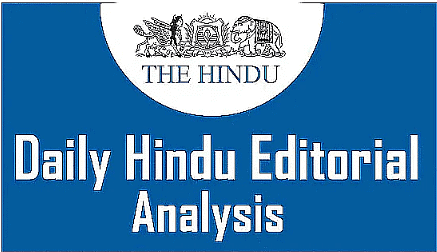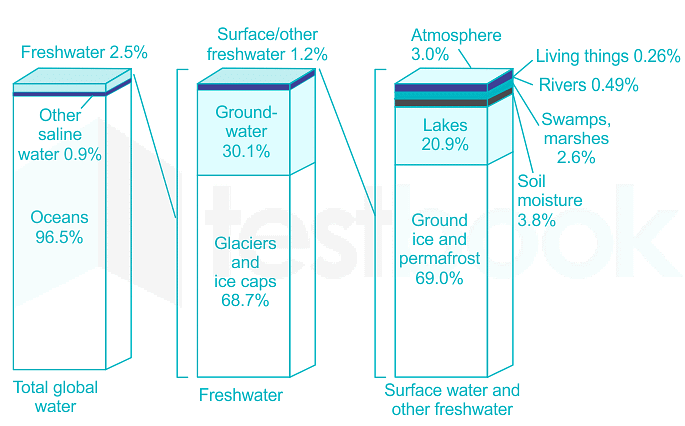The Hindu Editorial Analysis- 28th January 2023 | Current Affairs & Hindu Analysis: Daily, Weekly & Monthly - UPSC PDF Download

India’s groundwater governance is in better shape
Context
The government’s interventions for better and scientific management of the groundwater situation in India reflect the spirit of cooperative federalism in managing a precious resource.
- Data show that India, with nearly 18% of the world’s population, occupies about 2.4% of the total geographical area and consumes 4% of total water resources. A World Bank report says that India is the largest groundwater user. A rapidly growing economy and population are straining the country’s groundwater resources.
Introduction
Water Resources are sources of water that are potentially useful for humans. They can use water for a variety of purposes, including agriculture, industry, domestic use, recreation, and environmental preservation. Almost all of these uses need fresh water. Only about three percent of Earth’s water is freshwater. Water is the most valuable natural resource and a crucial component of a nation’s socioeconomic development.
What is Water Resources?
Water Resources are the various resources of water on Earth. About 71% of the surface of the earth is covered with water. However, the way that water is distributed on Earth appears to mean that only a small portion of the total amount of water that is present is fit for human consumption. The detailed distribution of water is shown below in the image.

The objectives of water resources are as follows:
- Encouraging settings for water resource use that are important socially, economically viable, and environmentally sustainable.
- Additionally, they aim to maximize the advantages and minimize the risks associated with the current hydraulic infrastructure.
- A common goal of all of these projects is to integrate policy approaches into other sectoral policies across a larger area of the nation. This frequently entails creating administrative, technical, and social water resource management tools.
- Every year World Water Day is observed on 22 March to raise awareness about water conservation. It was proposed by the United Nations.
In India, the primary source of water is rainfall. Approximately 2.45% of the world’s surface area, 4% of its water resources, and 16% of its population are all accounted for by India. About 4,000 cubic kilometers of water are available from precipitation in the entire nation each year. 1,869 cubic km are available from surface water and replenishable groundwater. Only 60% of this can be applied to good purposes. Consequently, the nation’s total usable water supply is only 1,122 cubic kilometers.
Ministry of Water Resources- In India there is a Ministry of Water Resources, River Development, and Ganga Rejuvenation which is the supreme authority in India for formulating and enforcing laws and rules governing the development and management of water resources.
- It was established in 1985 with a vision of “Optimal sustainable development, maintenance of quality and efficient use of water resources to match with the growing demands on this precious natural resource of the country”.
- The Headquarters of the ministry is located in New Delhi.
Water Resources can be classified into 2 major types
- Surface Water Resources
- Groundwater Resources
Let’s study each of the types in detail.
Surface Water Resources- The four sources of surface water are tanks, ponds, lakes, and rivers. About 10,360 rivers and their tributaries with an average length of 1.6 km exist in the nation. India’s river basins collectively have an estimated mean annual flow of 1,869 cubic km.
- However, only about 690 cubic km (32%) of the available surface water can be used because of topographical, hydrological, and other limitations.
- The amount of rainfall within a catchment area and the size of the catchment area determine how much water flows through a river. The Ganga, Brahmaputra, and Indus rivers in the nation all have substantial catchment areas.
- Rivers & Drainage System of India: The catchment areas of the Ganga, Brahmaputra, and Barak rivers receive a disproportionately high amount of precipitation, accounting for 60% of the country’s total surface water resources despite covering only about one-third of its total area. While the Brahmaputra and Ganga basins have yet to be developed, much of the annual water flow in south Indian rivers like the Godavari, the Krishna, and the Kaveri has been utilized.
- About 432 cubic km of replenishable groundwater is present in India. In the river basins located in India’s north-western region and some areas of the south, there is a relatively high level of groundwater utilization.
- The states of Punjab, Haryana, Rajasthan, and Tamil Nadu use a lot of groundwater. But some States, including Chhattisgarh, Odisha, Kerala, and others, only use a small portion of their groundwater potential.
- Moderate groundwater use is occurring in states like Gujarat, Uttar Pradesh, Bihar, Tripura, and Maharashtra. If the current pattern continues, there will be a need for supplies to meet the water demands.
- Furthermore, such a situation could lead to social unrest and disruptions as well as be harmful to development.
- The Ninth edition of the International Conference of Groundwater 2022 will be held in November. This conference brings together many domains of groundwater hydrology.
Watershed management refers to basic concepts of efficient management and conservation of surface and groundwater resources. A variety of techniques, including percolation tanks, recharge wells, etc., involves preventing runoff and storing and recharging groundwater. But in a broad sense, watershed management entails the preservation, renewal, and wise use of all-natural (such as land, water, plants, and animals) and human resources within a watershed.
- The goal of watershed management is to achieve equilibrium between society and natural resources. Community involvement is crucial to the development of watersheds.
- Numerous programs for watershed development and management have been launched nationwide by the federal and state governments.
- Nongovernmental Organizations (NGOs) are also putting some of these into practice.
- According to the UN World Water Development Report 2022, published by UNESCO, groundwater has the potential to offer societies tremendous social, economic, and environmental benefits and opportunities because it makes up about 99% of the liquid freshwater on Earth.
When the use of water is hampered by poor quality or when demand exceeds supply during a specific time period. This phenomenon is known as Water Stress. It occurs due to the depletion of water resources. The causes that led to the depletion of water resources are listed below:
- Pollution: The majority of the wastewater from industries is dumped into these water sources. This ultimately contaminates and pollutes water. This is yet another factor that contributes to the depletion of water supplies.
- Saltwater Contamination: It occurs when freshwater sources deep in the earth are contaminated with saltwater. This consequently decreases the supply of usable water.
- Unreasonable Demand for Water: The demand for water has significantly increased as a result of population growth. Over time, greater amounts of water are used and wasted.
- Deforestation: Water depletion is primarily caused by deforestation. Large-scale deforestation significantly reduces the soil’s ability to retain water, which has an impact on the water.
- Poor storage of Water: A lot of rainwater is lost due to inadequate storage facilities. The ability to collect rainwater and store it for later use has not advanced significantly technologically. Again, ignorance causes significant water to be lost. Again, this results in depletion.
- Low precipitation: There has been a significant decline in Precipitation and Distribution of Rainfall over time. Large-scale deforestation and abrupt climatic changes are the main causes of this. These contribute to the decrease in water resources.
- Urbanization is a phenomenon that both the government and the populace support. Widespread deforestation has significantly impacted water resources.
- Seepage: A significant amount of water is lost when the collected water is transported through the canals and pumps. This water seeps into the ground. Again, this results in depletion.
- Evaporation: As a result of climate change and global warming, more surface and groundwater is evaporating as a result of the intense heat. Evaporation causes the water level in the reservoir and dams to decrease.
- Agriculture: As agricultural activity increases day by day, more water is pumped for use in the process. More groundwater is pumped for agricultural purposes because it is free. A bore well can be fixed to accomplish this. This lowers the water levels that are causing its depletion.
Historically, India has had an agricultural economy, with about two-thirds of its people dependent on agriculture. As a result, the Five Year Plans have given the development of irrigation to boost agricultural production a very high priority, and projects for multipurpose river valleys, such as the Bhakra-Nangal, Hirakud, Damodar Valley, Nagarjuna Sagar, Indira Gandhi Canal Project, etc., have been started.
- In actuality, irrigational needs currently account for most of India’s water demand. 89 percent of surface water and 92 percent of groundwater are used for agricultural purposes, which also uses the majority of both resources.
- While the industrial sector only uses 2% of the available surface water and 5% of the available groundwater, the domestic sector uses a higher percentage (9%) of the available surface water than the industrial sector.
- Compared to other sectors, the agricultural sector uses a much larger percentage of the total water supply. However, as the nation develops, it is likely that the proportion of domestic and industrial sectors will rise.
- In India, surface water resources are about 70% polluted. Wastewater from various sources, intensive agriculture, industrial production, infrastructure development, untreated Urban Flooding, and wastewater are the main causes of water pollution. WHO estimates that half of India’s morbidity is caused by water.
- In India, particularly in cities, waste generation is increasing daily, but waste management has not been as effective as needed to handle this growth.
- Only 29% of the waste produced in urban habitations with a population greater than 50,000 is currently being treated by municipal wastewater systems in India, and this gap is expected to widen.
- A sizable portion of India’s water pollution is caused by domestic effluents. More than 70% of domestic wastewater that hasn’t been treated is dumped into the environment.
- According to the Central Pollution Control Board (CPCB), water quality data, bacterial and organic contamination of water bodies is becoming more and more of a problem, gradually lowering the quality of the water. Most Indian rivers’ biological oxygen demand (BOD) is rising and exceeding standards.
|
63 videos|5408 docs|1146 tests
|





















